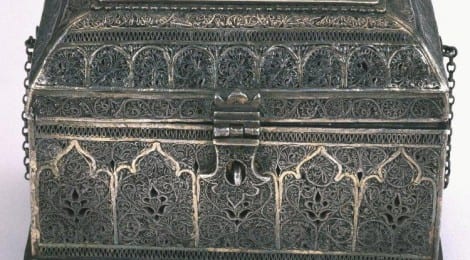
The attar casket of Tipu Sultan Case Study
This intricately-decorated filigree casket is currently on display in the Addis Gallery of Islamic Art, located by the north entrance of the British Museum. Inside are six small bottles, a ladle and a funnel which bears a minute Persian inscription on the rim. Many aspects of this object and its history piqued our interest: the enduring significance of Tipu Sultan, the particular attention paid by family members to transfer the casket between generations both in India and England as well as how material culture represented the legacy of East India Company family histories. This last aspect particularly reflects other family case studies in the East India Company at Home project.
The Persian inscription believed by the Frasers to refer to Hyder ‘Ali[2], Tipu Sultan’s father (c.1722-1782) brought our attention to how this object might represent collections and connoisseurship as a means of establishing dynastic legitimacy not only by East India Company families, but also within the court of Mysore.[3] Furthermore its placement in the Islamic gallery alongside objects related to Mughal India prompted questions about the interpretation and representation of imperial stories within the British Museum.
To read the case study in full, click here.
[1]http://www.britishmuseum.org/research/search_the_collection_database/search_object_details.aspx?objectid=249650&partid=1&searchText=1904%2c1006.1.a&fromADBC=ad&toADBC=ad&numpages=10&orig=%2fresearch%2fsearch_the_collection_database.aspx¤tPage=1 Accessed 10 May 2013. The casket’s British Museum number is 1904,1006.1.a-i.
[2] Accepted spellings include ‘Haidar’, ‘Haider’, ‘Hayday’ and ‘Hayder’. For consistency ‘Hyder’ will be used as on the letter attached to the casket.
[3] Maya Jasanoff, Edge of Empire: Conquest and Collecting in the East 1750 – 1850 (London: Fourth Estate, 2005), p. 184.


Recent posts